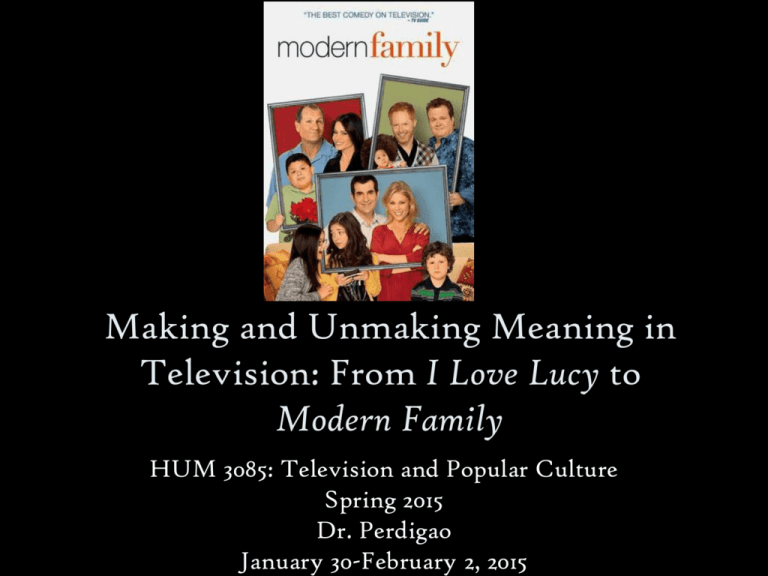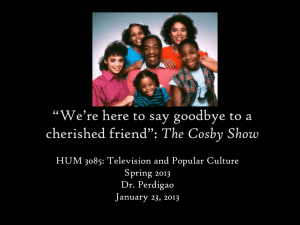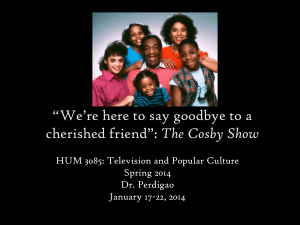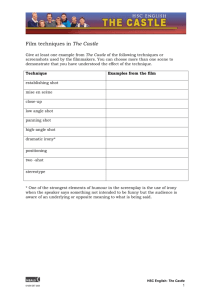Day 5: Television Narrative
advertisement

Making and Unmaking Meaning in Television: From I Love Lucy to Modern Family HUM 3085: Television and Popular Culture Spring 2015 Dr. Perdigao January 30-February 2, 2015 Modes of production • Multi-camera live studio production: origins in radio, adaptation in 1940s in television (Mittell 164) • Almost every form of television in the 1940s was broadcast live; exceptions in 1940s and 1950s in stand-alone plays, anthology drama (167) • Single-camera telefilm production: from early days but increase in popularity • Base in Los Angeles vs. New York (168) • Hollywood filmmaking • Single camera to shoot scene from particular angle • Master shot as distant shot to cover entire scene (168) Experiments in Form • Extensive postproduction process but benefits in flexibility in location shooting • Durability and high-quality of the medium, higher resolution (Mittell 169) • Dragnet (1951-1959) as breakthrough program to popularize telefilms on major network (169) • Quality of picture in reruns as another benefit (170) • Multi-camera telefilm studio production: example of I Love Lucy, hybrid form • Demands of actors—production in Hollywood and shooting on film (171) • Desilu Studios created to absorb the costs, financing the show (172) The Great Divide • Performed in television studio in front of a live audience but cameras recorded action to tape, then editing in post-production (Mittell 172) • Emergence of videotape in the 1950s as key development that innovated the medium (173) • Live-to-tape programming popular in the 1960s • Live-edited videotaped sitcoms: All in the Family, Roseanne, Everybody Loves Raymond • Live-edited videotaped sitcoms feature “limited settings, character relationships, and longer scenes”; themes “emphasize domestic life and the community of a family or workplace” (175) Experiments in Form • Most comedies shot in multi-camera studio mode, with live audience giving feedback (Mittell 252) • Live broadcast in early 1950s, shift after I Love Lucy’s use of multi-camera telefilm system, live-to-tape model in the 1970s (252) • Single-camera telefilm system: M*A*S*H (1972-1983), 1990s and 2000s: Malcolm in the Middle (2000-2006), My Name is Earl (2005-2009), The Office (2005-2013) (252-253) • Telefilm sitcoms feature “more editing, varied locations, and multiple storylines that are controlled and paced through postproduction editing” (Mittell 175) Modernization and Resuscitation • Modern Family premiered on September 23, 2009 on ABC • http://www.imdb.com/title/tt1444504/ • Success for network that had rejected The Cosby Show, saying that sitcoms were dead • Self-analysis worked into show’s format, self-analysis, self-exposure • “Baring the device,” breaking the fourth wall • Use of the set, staging • The Cosby Show and the Huxtable home • Multi-camera mode, live studio • Single camera, three storylines in Modern Family An Evolving Form • Television texts to be “read,” interpreted • Text: “any bounded communication system that can be analyzed, from a novel to a billboard, a piece of music to a painting” (Mittell 159) • “Texts need not be grounded in language, as visual and aural expression convey meaning and can express ideas. Television programs are clearly texts for the purposes of analysis, offering a range of meanings expressed through visual, sonic, and linguistic cues” (Mittell 159). • For interpretation, uses of terms/theories from the study of film, literature, visual art, music, and theatre • Also recognition of the distinctions of the medium (Mittell 159) Stylistic analysis • Staging: set, props, lighting, costume, makeup, and actor movement and performance (Mittell 177) • Film’s mise-en-scène (177) • Camerawork • Capturing the image, style of shooting • Speed of motion Perspective • Lenses • Focal length: “alters the degree of magnification and depth of an image” (Mittell 185) • “[A] long focal length makes objects appear closer to the camera than they truly are, while shorter focal lengths can create the illusion of objects appearing farther from the camera” (185) • Telephoto lens: used to “capture images from far away” (185) Perspective • Wide-angle lenses use short focal lengths; “fisheye” distortion but allow panoramic shots (185) • Longer focal length=compresses depth, flattened image (185) • Shorter focal length=increases depth, deeper space (185) Focus • Depth of field: “range of distance from the camera in which images can be in focus” (187) • Rack focus: Alters focal plane to shift what part of the image is sharp and clear; changing focus from one character to another (background vs. foreground in focus, quick change) (188) • Framing: camera constructing the image, giving sense of space • Establishing shot: Extreme long shot that “sets the scene from a distance” (189) • Long shot: More details in a scene, sense of space (190) One fish, two fish • Two shot: Two people converse within the frame • Three shot: Three characters • Two shot west: Soap operas; one person stands in front of the other, both peer beyond the camera; two do not see each other’s reactions (191) • Closeup: Intimacy and emotional expression, fills frame with person’s face (192) • Medium closeup: Frames person’s chest to top of his head Orientation • Extreme closeup: “[A]llows an isolated detail, object, or body part to fill the screen” (192) https://www.youtube.com/watch?v=QZhXuawVRHU • Low angle shot: Camera shooing from below, making object/people seem larger • High angle shot: Camera shooting from above, making object/people seem smaller (192) • Canted shot: Camera shoots at an angle, creating sense of disorientation (192) Camera movement • Tilt • Dolly and tracking shots • Crane shot • Hand-held cameras Editing • Continuity editing: Natural, realistic feel; continuity of time, space • Cut: Switch from one shot to another (197) • Jump cut: “jars and distorts viewers by breaking continuity” (196) • Shot/reverse shot: Back-and-forth editing between closeups in a dialogue (197) Transitions • Fade-outs: To a black screen • Fade-ins: From black screen to illumination • Dissolves: Transition from one shot to another, images briefly overlapping (200) • Wipes: Line or shape appears on the screen as one image is replaced with another (200) Fragmentation • Cross-cutting: Establishes parallels between storylines, continuity (200) • Flashback: Transition to earlier point in the story • Split-screen: Division of physical space of the frame (204) Storytelling • Diegesis: The world created in the text, storytelling • Diegetic sound: Sound characters can hear: dialogue, noises within the scene, and music onsite (209) • Nondiegetic sound Sound only audience can hear, soundtracks, etc. (209) • Voiceover narration, often as framing device at the episode’s beginning and end • Internal voice of character; ex: Carrie’s narration on Sex and the City as diegetic, originating in storyworld • Extradiegetic narration: Existing in storyworld but not emerging from on-screen action; ex: Mary Alice from beyond the grave in Desperate Housewives or the retrospective narrator Kevin on The Wonder Years Periodization • Production, distribution, and transmission as the exchange of programming (Mittell 19) • Production company manages the creative process (oftentimes subsidiaries of film studios) • Logos or bumpers at the end credits of programs https://www.youtube.com/watch?v=NCLPHSVtvmU https://www.youtube.com/watch?v=BC-eFU6OgxA Productivity • Deficit financing: significant debt for first few years of a series; license fees only covering a portion of production costs—financial gains with longer running series (Mittell 22) • Showrunner: coordinator manages production process from concept through the series (Mittell 22) • Standards-and-practices department for each network (Mittell 26) • Hollywood studios mostly producing or co-producing fictional programming but independent television producers have played significant roles, decreased (not deceased) function since 1990s (Mittell 23) • Independent television producers: Desilu Productions (I Love Lucy, Star Trek), Carsey-Werner Company (The Cosby Show, That ‘70s Show) Redefining • Shift from Network Era in 1980s and 1990s with new networks: Fox in the mid 1980s and UPN and the WB in the mid-1990s • WB and UPN disbanded, recreated as The CW (co-owned by Warner Bros. and Viacom) • Counter-program as series targeting different audience (29) • Logos and snipes, or pop-up ads advertising new series (30) • Branding network identities (30) • Cable and satellite channels (31) • MTV and branding (32) [What, MTV and music videos?] Hybrids Don’t Just Appear on The Vampire Diaries • Syndication as model of distribution; no centralized schedule or channel identity (Mittell 33) • Formulas • Innovation, imitation, saturation (Mittell 46) • Spin-off: Buffy to Angel • Franchise: Law & Order, CSI • Clones • Recombinants: Roswell=X-Files + Beverly Hills, 90210? (Mittell 46)







